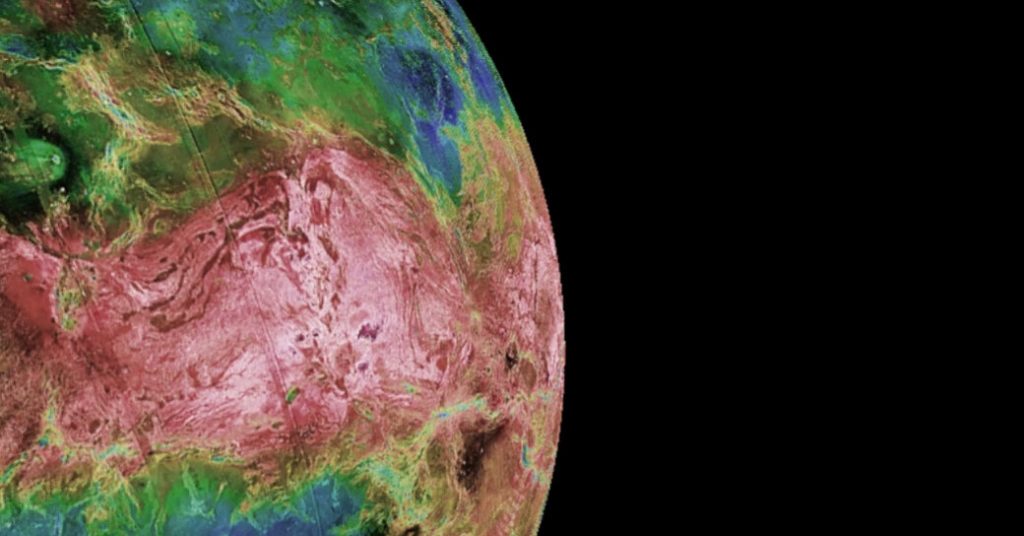
Venus is so hot that its surface is clearly illuminated at night through its thick clouds.
This is revealed by images taken by NASA’s Parker Solar Probe.
The planet has an average temperature of about 860 degrees Fahrenheit, and thick clouds of sulfuric acid obscure the view. So far, the only images of the surface of Venus have been taken by four Soviet spacecraft that successfully landed there in the 1970s and 1980s, working for a while before succumbing to the infernal outskirts.
During a Venus flyby, the Parker spacecraft pointed its cameras at the night side of Venus. He was able to see visible wavelengths of light, including reddish colors near infrared that could pass through clouds.
“It’s a new way of looking at Venus that we haven’t tried before — in fact, we weren’t sure if that was possible,” said Laurie Glaese, director of NASA’s Planetary Division.
In Parker’s images, hotter regions like the lower volcanic plains looked brighter while those at higher altitudes like Aphrodite’s Terra, one of three continent-sized regions on Venus, were about 85 degrees cooler and darker.
Brian Wood, a physicist at the Naval Research Laboratory in Washington, D.C., and lead author of A study published this month in Geophysical Research Letters which described the results. “It starts to glow a little bit at very red wavelengths. And this is what we see: the surface of Venus is glowing at very red wavelengths, because it’s so hot.”
The images also showed a halo of luminous oxygen in the atmosphere.
“We were able to take these really beautiful, amazing images,” said Nicola Fox, director of NASA’s Solar Physics Division.
For Dr. Wood and other scientists working on the mission, the research was a crash course in planetary science. “I’ve never studied planets,” Dr. Wood said. “We are all solar physicists. We are experts on the sun, not the planets.”
As its name indicates, the Parker Solar Probe’s mission is to scan the sun, enduring scorching temperatures as it dives into the sun’s outer atmosphere. By design, the Parker spacecraft’s trajectory makes several close flights to Venus, using the planet’s gravity as a brake to allow it to get closer and closer to the Sun.
The single camera instrument, known as the Wide-Field Imager for Parker Solar Probe, or WISPR, is not designed to look directly at the sun, which is very bright, especially at close distances. Instead, WISPR is symmetric to the side, at which charged particles known as the solar wind are blasting off the sun at a speed of one million miles per hour.
Before launching the Parker Solar Probe in 2018, Dr. Glaze and Dr. Fox, who was then the project scientist for the mission, discussed the possibility of operating the instruments during Venus flybys. But it wasn’t until after launch that confirmed plans were made and the Parker Space Probe was running smoothly.
“This was only due to safety concerns,” Dr. Fox said. “Until you get into orbit, you don’t really know how to fly your spacecraft.”
Designed to capture faint solar wind particles, WISPR has been shown to be adept at bringing out the faint glow on the night side of Venus.
It took a little trial and error to find out. In July 2020, on the first flight where the camera was turned on, scientists discovered that if any part of the day side of Venus was in the field of view, the image turned out to be very overexposed.
“We didn’t really know what we were doing,” Dr. Wood said. “We quickly learned that this results in an image that is completely unusable.”
But there were only two photos of the night side. “These are the images that revealed to us, ‘Wow, well, now we’re seeing something,'” Dr. Wood said.
Scientists were more prepared when their spacecraft took flight again in February of last year, and took enough pictures to put it together on film.
Other orbiting spacecraft, including Japan’s Akatsuki and the European Space Agency’s Venus Express, have detected similar patterns at longer infrared wavelengths, which are invisible to the human eye. (Whether an astronaut in orbit above the night side of Venus would see the glow detected by Parker is unclear, Dr. Wood said, because the human eye can barely detect these wavelengths.)
Since different materials glow at different intensities and at different wavelengths, it may be possible to combine Parker’s data with infrared observations from other spacecraft to help identify some of the minerals on the surface.
“This is where we’d like to go with this data, but we’re not quite there yet,” said Dr. Wood.
The data will also help future Venus missions like NASA’s DAVINCI+, which is scheduled to launch at the end of the decade and send a parachute probe to the surface. “I think it’s going to be a really exciting time,” said James Garvin, principal investigator for DAVINCI+. “The flower will live.”
The Parker Space Probe won’t get another good look at the night side of Venus until its last flyby in November 2024.
Dr. Wood notes a historical consistency with his discoveries of Venus. In 1962, the first successful planetary probe, NASA’s Mariner 2 mission to Venus, confirmed the existence of the solar wind. This was a prediction of Eugene Parker, the namesake astrophysicist for the mission he is now working on.
“I find it fascinating that this link between Venus research and solar wind research has been around from the start,” said Dr. Wood.

“Web maven. Infuriatingly humble beer geek. Bacon fanatic. Typical creator. Music expert.”





More Stories
Scientists confirm that monkeys do not have time to write Shakespeare: ScienceAlert
SpaceX launches 23 Starlink satellites from Florida (video and photos)
A new 3D map reveals strange, glowing filaments surrounding the supernova